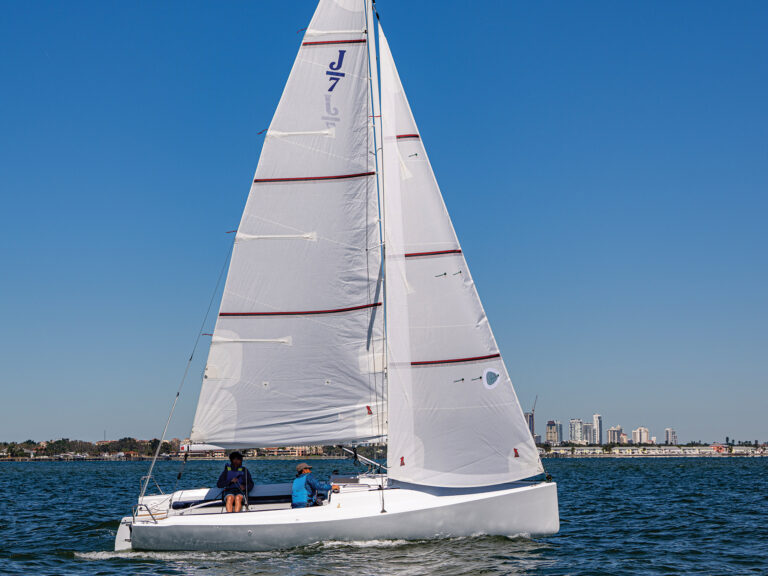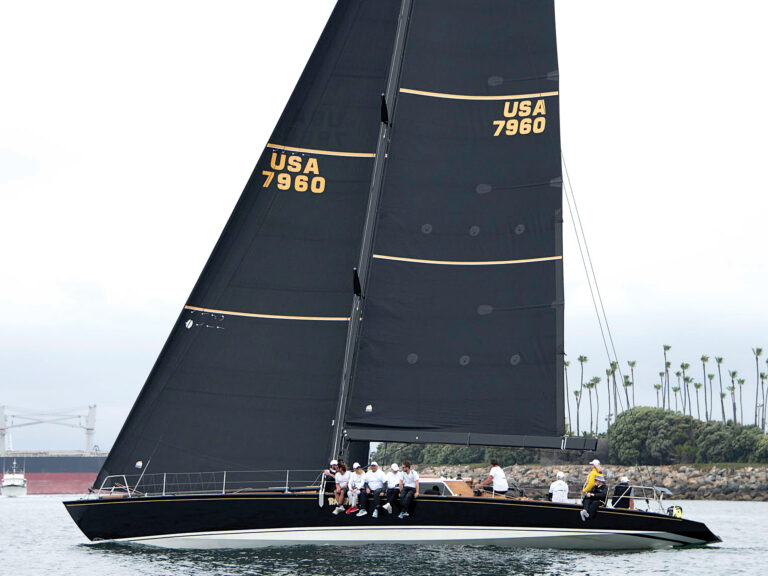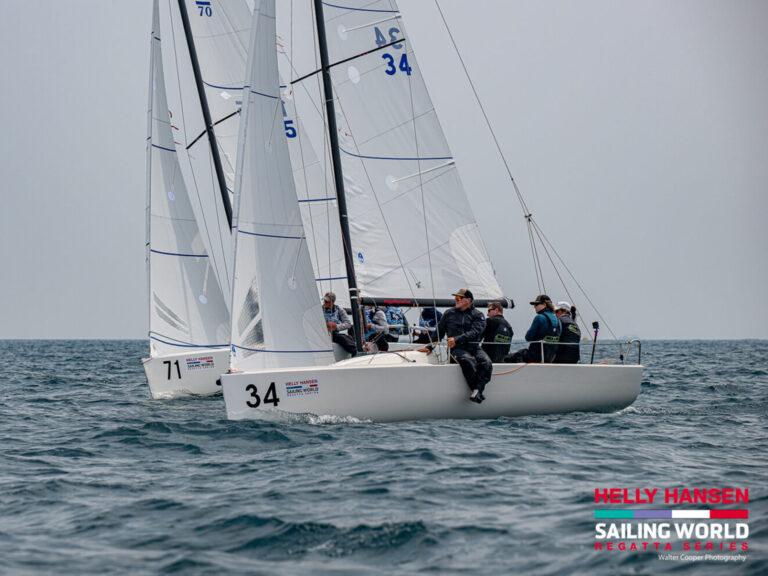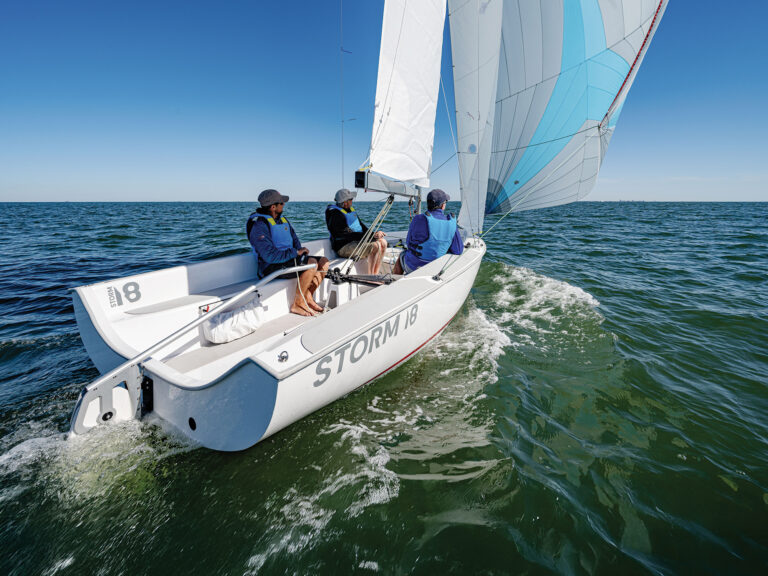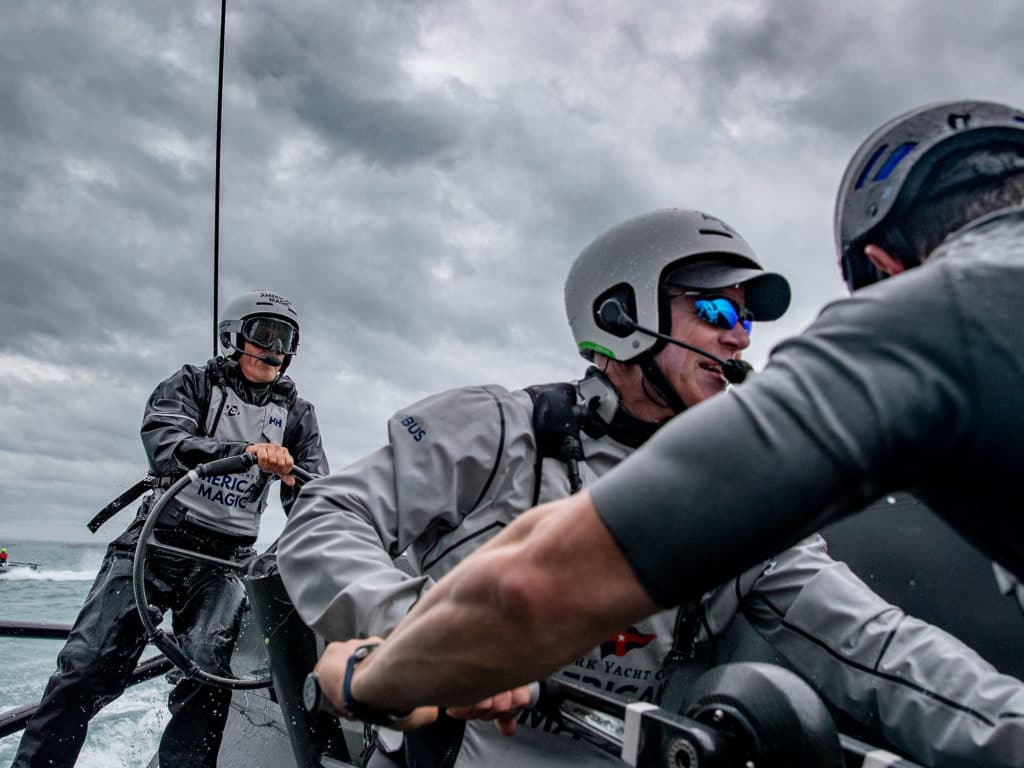
One final burn back to the barn onboard American Magic’s AC75 Defiant is one experience Terry Hutchinson won’t soon forget. At the conclusion of another long day of training in late September, helmsman Dean Barker pointed the bulbous blue bow toward the base, some 11 miles away, with a 12-knot breeze tickling the back of his neck. Fifteen minutes later, they were home, having almost cracked the 50-knot barrier along the way.
“It was exciting,” says Hutchinson, who experienced the high-speed tear from the boat’s 12th-man spot in the transom. “It was the first time I’d ever sailed in that spot and it was really good to see the starboard side of the yacht. I was hanging on for dear life because, at 40 knots there’s a lot of movement back there.”
The jovial banter over his comms unit as his teammates chased the elusive five-oh on the speedo, passing powerboats as if they were standing still, is what he remembers most. “It was really cool,” he says, “and it was impressive to see the level of comfort. It’s like when you hear the Formula 1 guys talking to their pit guys as they’re going around the track at more than 100 miles per hour. Just awesome.”
When Defiant finally came to rest alongside the team’s tender, Hutchinson could finally relax and exhale, knowing the boat had more than served its purpose on the long, complex and calculated path to the America’s Cup Match in March 2021. It was the final day for Defiant, which the shore crew would begin decommission and focus its full resources on Patriot, the team’s second AC75, which will be sailing by mid-October.
Patriot, shipped from its build facility in Rhode Island to Auckland in the belly of an AN-124 transport aircraft in early September, is more than halfway through its four-week fit-out, says Hutchinson, as a result of 24-hour shifts inside the base since its arrival. “When we were sailing one boat and finishing out the other one, that 24-hour shift was huge because it allowed us to do both operations,” he says. “Now we have twice as many hands working on Patriot, which has been great.”
It’s all seemingly going according to plan, Hutchinson jokes, especially given the COVID-19 curveballs thrown at challengers and Defender alike. Through luck and good planning, they appear to be one step ahead of major disruptions.
“We started sailing [in Auckland] on July 27, which was about seven days earlier than what we had planned for pre-COVID,” he says. “To meet that milestone is pretty amazing. The time in the simulator kept everyone up to speed, and the motivation among the guys to go sailing when we got here was essential to getting us on the water and being efficient with our days.”
From their first Auckland outing to Defiant’s final day, Hutchinson says, the team logged 26 days of on the water, losing only two weeks to weather. It’s also worth noting, he adds, that the New Zealand winter has been the warmest on record since 1903. In fact, warmer than their winter session in Pensacola, Florida.
Fortune presents itself in many ways, and their quality time on the water in the eyesight of Defender, Emirates Team New Zealand, is yet another boon. “The pressure of having them across the harbor has been a positive as well because it gets us out sailing in conditions that we might not go out in because it’s too windy. There’s a certain level of pride that comes from executing in those days. The gain rate is exciting.”
How much faster they are today than when they left Pensacola in March is impossible to quantify, Hutchinson says, but “we’re going in the right direction.”
Everyone else is as well, however: “It’s now getting very real,” he adds. “We’re in the venue and don’t have the ability to hide.”
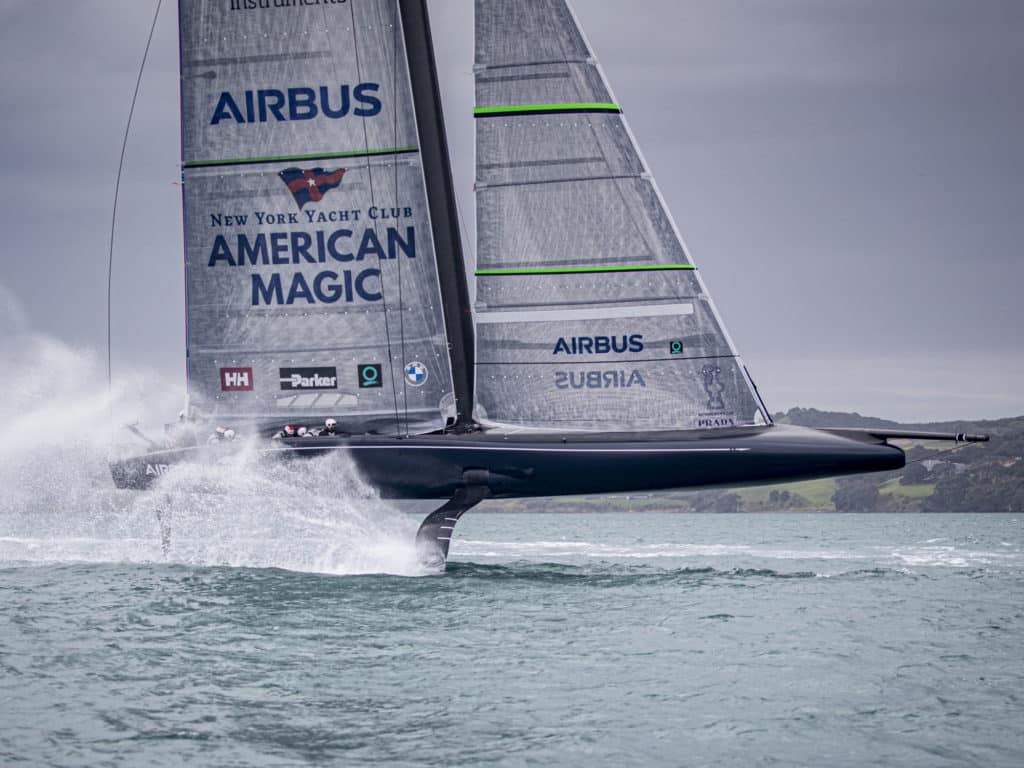
From images and videos shared by the team, as well as footage captured by land-based observers, there’s been plenty of training conducted in wind strengths well beyond the limits in place for the pre-Cup races, starting with the Christmas Cup in December. “The knock-on effect of sailing into the upper wind range is the confidence you come in off the water with,” Hutchinson says, “the guys get over the intimidation and start sailing the boat better every time. The more comfortable you are in that sort of environment, each day becomes just a race day—nothing more, nothing less.”
And building that comfort level also includes the inevitable capsize, which the team recently experienced. Like no big deal, the AC75 was reportedly righted in 4 minutes. The rig and the array of hydraulics inside the boat were inspected before they were cleared for a few more hours of high-wind sailing.
he capsize happened in slow motion, much like that of Emirates Team Zealand’s earlier in the year. “We were hauling the mail [in 24 knots of wind] and when we bore away the foil arm dug in really hard,” Hutchinson says. “When the boat decelerates like that the apparent wind goes aft very quickly and the momentum of the rig pushes you over. We were sailing through the apex of the acceleration, so anything that causes deceleration on these boats is no bueno. We all got a chuckle on the comms, made sure everyone was OK, got the bow line on, pulled her into the wind and up she came. No harm, no foul.”
Having inadvertently checked off “capsize recovery” from their to-do list and begun preparing Defiant as an “insurance policy,” Hutchinson says the effort is now fully on commissioning Patriot, which is rumored to be different enough to give spies and Cup watchers plenty upon which to speculate.
How different?
“I’m not going to give you much,” Hutchinson says, ever careful to hint at anything that would tip off his competitors too soon, “but if you look at the evolution of all the boats, the position that INEOS [Team UK] and us are in—because we didn’t have the class rule as long as the defender and challenger of record—our opportunity to make big gains between hulls one and two is substantial. The Defender and Challenger of Record have very nice platforms. There are features of both of those team’s boats that other teams like, so I expect to see all the teams gravitating in that direction.
“You won’t be disappointed,” he concludes. “Defiant has been a great boat for us. It’s taken us a bit of time to sail it to its potential and we were still just scratching the surface, so it’s been the right platform for us to learn on.”
While American Magic’s crew has yet to sail Patriot, they have spent plenty of time with it in the simulator, which has certainly become the most powerful proprietary tool of this Cup cycle. Still, nothing beats time on the water with a new boat.
“There will be a certain component of starting over,” Hutchinson says, but that’s the exciting thing because Defiant taught us certain techniques, and with Patriot those techniques will be different.”
Looming in the near future, he adds, is the racing itself, and there is a level of anxiety among all the teams. For the past year, each syndicate has been exclusively focused on their AC75 development, and with cancellations of events in Italy and England, the Christmas Cup will be revealing—for better or worse. “This will be the first America’s Cup for all the teams where they’ve come into the main event and have not done any racing, which is terrifying in itself,” Hutchinson says. “You can only simulate racing in practice and in the simulator, so there is always an added pressure when there’s another boat on the course next to you. There’s a lot of investment that goes into this and it’s all decided on the water in a short period of time.”
The Defender, he admits without pause, is a polished team, and the benefit of now being on the same waters is critical: “We see a lot of clever thinking, so we like being around them, and learning from them is a real opportunity. If we were to go racing with them today, we’d have our hands full, but that’s OK. We’re focused on the results, but we’re also focused on the details to get that result.”





